J Korean Soc Transplant.
2017 Jun;31(2):68-74. 10.4285/jkstn.2017.31.2.68.
Legislative Issues Regarding Transplant Act
- Affiliations
-
- 1Department of Social Studies Education, College of Education, Ewha Womans University, Seoul, Korea.
- 2School of Law, Ewha Womans University, Seoul, Korea. phlaw@ewha.ac.kr
- KMID: 2385531
- DOI: http://doi.org/10.4285/jkstn.2017.31.2.68
Abstract
- The Korean Transplant Act has been revised five times since 1999, and each revision has resulted in a slight donation rate increased; however, the organ shortage had not been solved. As a result, further revision of the Transplant Act is needed. The current focuses solely on efficiency for transplantation. Therefore, this study suggests a paradigm shift in the revision of the act through the virtuous cycle for activating donation; namely, from an efficiency-based transplant system to a donor-centered transplant system.
Keyword
MeSH Terms
Figure
Reference
-
1). Ministry of Government Legislation. INTERNAL ORGANS, ETC. TRANSPLANT ACT [Internet]. Sejong: Ministry of Government Legislation;2017. [cited 2017 May 20]. Available from:. http://www.law.go.kr/lsSc.do?menuId=0&subMenu=2&query=%EC%9E%A5%EA%B8%B0%EB%93%B1.2). Ministy of Health and Welfare. 2015 Ministry of health and welfare repubic of Korea. Sejong: Ministy of Health and Welfare;2016. 832. (보건복지부. 2015년 보건복지부백서. 세 종: 보건복지부; 2016: 832.).3). Korean Organ Donation Agency (KODA), Reports on information management of Brain death candidates [Internet]. Seoul: KODA;c2015. [cited 2017 May 20]. Available from:. http://www.koda1458.kr/koda/history.do.4). Korean Network for Organ Sharing (KONOS). 2015 Annual Report on Transplantation. Seoul: KONOS;2016. (질병관리 본부 장기이식관리센터. 2015년 장기등이식 통계연보. 서울: 질병관리본부 장기이식관리센터; 2016.).5). KIM HC., Kim MH, et al. A research on the Integrated management of therapeutic human resources. Seoul: Ministry of Health and Welfare;2014. 226-43. (김현철, 김명희, 등. 이식용 인체자원 통합관리 방안 연구. 서울: 보건복지부; 2014: 226-43.).6). Kim HC., Kim JA, et al. A study of the Korean legal institutionalization of the UNESCO Universal Declaration on Bioethics and Human Rights. Sejong: Korea Legislation Research Institute:. 2016. 216–55. 341-4. (김현철, 김정아, 등. UNESCO 생명윤리와 인권 보편선언의 국내법적 제도화에 관한 연구. 세종: 한국법제연구원; 2016: 215-55, 341-4.).7). Korea Organization for Sharing Tissue (KOST). A study on compensation of tissue donors' relatives. Seoul: KOST;2011. (한국인체조직기증지원본부. 조직기증자 유가족 보상에 대한 연구. 서울: 한국인체조직기증지원본부; 2011.).8). Park SH., Kim HC, et al. Policy Report on Activation for Human Tissue Donation. Seoul: Industry Academic Cooperation Foundation Sookmyung Women's University;2016. 172-200. (박수헌, 김현철, 등. 인체조직 기증 활성화 방안 에 관한 연구. 서울: 숙명여자대학교 산학협력단; 2016: 172-200.).
- Full Text Links
- Actions
-
Cited
- CITED
-
- Close
- Share
- Similar articles
-
- Self-Quarantine System and Personal Information Privacy in South Korea
- Enactment of a Law for Governmental Support of the Use of Cord Blood, and Ethical Issues
- Issues and Proposal of Research Process in Use of Cadaver According to Changes of Act on Dissection and Preservation of Corpses
- Legal Issues in Quarantine and Isolation for Control of Emerging Infectious Diseases
- Current Issues and Perspectives on School Health Programs




